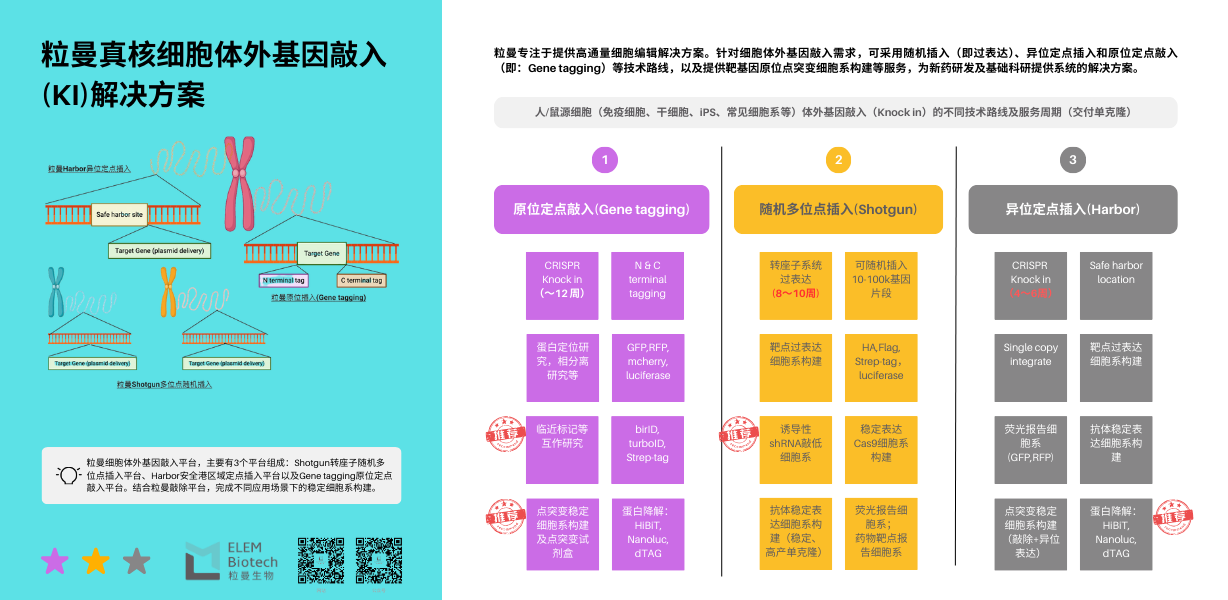Unit point integration Harbor stable cell line construction
Gene knock-in is an effective tool for achieving stable overexpression of genes. Stable cell lines play an important role in recombinant protein preparation, antibody preparation, drug screening, gene function research, and other aspects. Stable cell lines can continuously grow and stably express foreign genes. According to the research or application direction, the expression level of the exogenous gene in the target cells can be regulated by changing the number of inserted copies and the promoter activity, so that it is increased, decreased, or equal to the expression level of the endogenous gene in the target cells. The insertion methods of exogenous genes can be divided into random insertion or insertion at a specific location.
Liman uses its independently developed site-specific gene knock-in (gene knock in) pCargo-Harbor platform to insert the target gene into HEK293 the cells' AAVS1 safe harbor site. This method is superior to gene knock-in based on lentiviral and transposon systems, realizing the single-copy insertion of the target gene at the safe harbor site in the cells. This insertion site is a transcriptionally active site and does not affect the function of other genes, and the resulting cells have consistent genotypes, uniform expression, and genetic stability. AAVS1 The insertion site is a transcriptionally active site and does not affect the function of other genes. The resulting cells have consistent genotypes, uniform expression, and genetic stability.

Liman HEK293 Harbor Advantages of constructing stable cell lines with overexpression
1. Uniform Genotype : The resulting cells have consistent genotypes, uniform expression, and genetic stability;
2. Site-specific insertion : site-specific insertion of the target gene at the safe harbor site in the cells; AAVS1 Site-specific insertion of the target gene into the cells' safe harbor site;
3. Simple operation, short cycle: Compared with the lentivirus and transposon systems, it takes a shorter time to obtain stable cell lines with uniform expression.
Liman HEK293 Harbor Workflow for constructing stable cell lines with overexpression
1. Vector construction : Construct the target gene into Liman's unique stable transfection plasmid system pCargo vector. (Cycle 1 weeks)
2. Cell transfection: Using the transfection reagent transfection method, the pCargo plasmid is delivered to HEK293 Harbor the cells. Using Liman's developed site-specific recombination technology, the HEK293 Harbor cells are used to integrate a target gene controlled by a strong promoter EF1a single copy to the HEK293 safe harbor site of the cell genome. (Cycle 1 weeks)
3. Antibiotic selection: Stably and site-specifically integrated pCargo plasmid will enable the cells to obtain puro resistance, using puromycin(1ug/ml) to screen out cells that have integrated the target gene after transfection. Cells that have not integrated the target gene have no puro resistance and are puromycin killed. (Cycle 2-3 weeks)
4. Protein expression verification : Collect the cell precipitate after antibiotic selection and perform Western blot detection (cycle 1 weeks) or mass spectrometry analysis (cycle 2 weeks) to ensure normal expression of the target gene.
Welcome to contact the Liman team for pre-sales technical exchanges!

